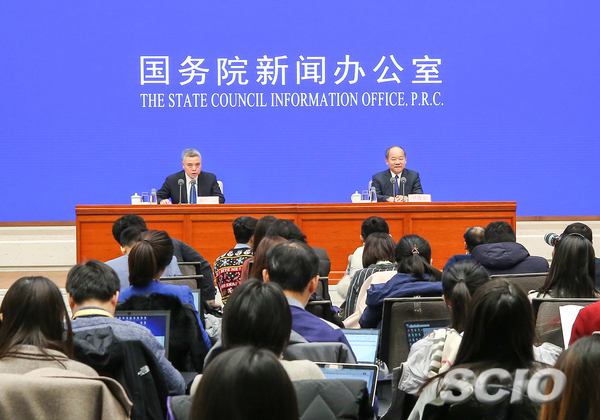SCIO briefing on China's economic performance in 2019
Speaker:
Ning Jizhe, head of the National Bureau of Statistics
Chairperson:
Hu Kaihong, spokesperson for the State Council Information Office of China
Date:
Jan. 17, 2020

Hu Kaihong:
Ladies and gentlemen, good morning. Welcome to this press conference. Today, we are delighted to invite Mr. Ning Jizhe, head of the National Bureau of Statistics (NBS), to introduce China's economic performance in 2019, and answer your questions. Now, I'll give the floor to Mr. Ning.
Ning Jizhe:
In 2019, China achieved overall economic stability and reached its main expected targets for economic development. Amid mounting risks and challenges both at home and abroad, different regions and government departments , under the leadership of the CPC Central Committee with Comrade Xi Jinping at its core, fully implemented the decisions and plans made by the CPC Central Committee and the State Council. They stuck to the general working guideline of making progress while maintaining stability, followed the new development philosophy, focused on supply-side structural reform, promoted high-quality development and strengthened efforts to maintain stability in employment, the financial sector, foreign trade, foreign and domestic investments, and expectations. Significant breakthroughs have been achieved in three tough battles. The national economy was generally stable, the quality of development has improved and the main expected targets have been achieved, thus laying a solid foundation for building a moderately prosperous society in all respects.
According to preliminary calculations, China's gross domestic product (GDP) was 99.09 trillion yuan in 2019, an increase of 6.1% over the previous year at comparable prices, and meeting our expected targets of 6% to 6.5%. The four quarters saw growth rates of 6.4%, 6.2%, 6.0%, and 6.0% respectively. The added value of industries were 7.05 trillion yuan, 38.62 trillion yuan, and 53.42 trillion yuan for the primary, secondary and tertiary industries, respectively, with growth rates of 3.1%, 5.7%, and 6.9%.
First, grain output reached a new record and the production of beef, mutton, poultry, eggs and milk increased.
Last year's total grain output was 663.84 million tons, up by 0.9% over that of the previous year and an increase of 5.94 million tons. This ensured that output levels were maintained above 650 million tons for five consecutive years. Summer grain output was 141.6 million tons, an increase of 2.0%; early season rice 26.27 million tons, down by 8.1%; and autumn grain output 495.97 million tons, up by 1.1%. The output of wheat was 133.59 million tons, up by 1.6%; corn 260.77 million tons, up by 1.4%; soybean 18.10 million tons, up by 13.3%.
The total output of pork, beef, mutton and poultry was 76.49 million tons, down by 10.2% over last year. In particular, the output of beef was 6.67 million tons, up by 3.6%; mutton, 4.88 million tons, up by 2.6%; poultry, 22.39 million tons, up by 12.3%; eggs, 33.09 million tons, up by 5.8%; milk, 32.01 million tons, up by 4.1%; and pork, 42.55 million tons, down by 21.3%.
Second, industrial production continued to increase, and high-tech manufacturing and strategic emerging industries grew rapidly.
In 2019, the industrial output increased by 5.7% over the previous year. The value-added of the state-holding enterprises went up by 4.8%, that of share-holding enterprises by 6.8%; enterprises funded by foreign investors or investors from Hong Kong, Macao and Taiwan up by 2.0%; private enterprises by 7.7%. In terms of sectors, the value-added of the mining sector increased 5.0%, that of manufacturing sector was up 6.0%, and that of producing and supplying electricity, heat, gas and water grew by 7.0%. The value-added of high-tech manufacturing sector rose by 8.8%, strategic emerging industries by 8.4% over the previous year, or 3.1 and 2.7 percentage points faster, respectively, than that of large industrial companies. In December, the industrial output grew by 6.9% year on year, or 0.7 percentage points faster than the previous month, marking an increase of 0.58% month on month. In December, the sub-indexes of the Purchasing Managers' Index (PMI), the Production Index, the New Orders Index and the Supplier Delivery Time Index reached 53.2%, 51.2% and 51.1% respectively, all staying above the threshold. The Business Activity Expectation Index for Manufacturing was 54.4%, staying within the expansion range.
In the first 11 months of 2019, the total profits of large industrial enterprises reached 5.61 trillion yuan, down by 2.1% year on year, but the decline was 0.8 percentage points lower than that of the first ten months. The profits of large industrial companies grew by 5.4% in November year on year, while that of October was down by 9.9%.
Third, the service sector grew fast with modern services sector gaining momentum.
In 2019, the Index of Service Production increased by 6.9% over that of the previous year. The value-added of information transmission, software and information technology services, leasing and business services, financial services, transportation, storage and post services grew by 18.7%, 8.7%, 7.2% and 7.1% respectively, or 11.8, 1.8, 0.3 and 0.2 percentage points faster than that of the tertiary industry. From January to November, the revenue of large service enterprises increased by 9.4% year on year. In particular, revenues of enterprises engaged in strategic emerging services, science and technology services and high-tech services increased by 12.4%, 12.0% and 12.0% respectively. Their growth rate was respectively 3.0, 2.6 and 2.6 percentage points faster than that of all large service companies. Profits of large service companies increased by 3.5%.
In December, the business activity index for services was 53.0%, continuing to stay above the threshold that separates growth from contraction. Specifically, the business activity indexes for sectors like railway transportation, lodging, telecommunication, broadcast, television and satellite transmission services, internet software and information technology services, financial services and leasing and business services all stayed within the high expansion range of 55.0% and above. From the perspective of market expectations, the business activities expectation index for services was 59.1%, maintaining a sound growth momentum.

